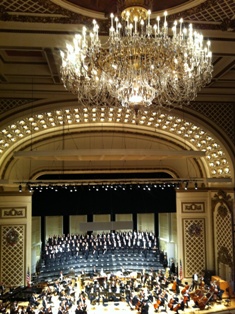
May Festival Opener Fulfills Tradition
For this listener, opening night of May Festival 2012 in Cincinnati's imposing, neo-Gothic Music Hall (built for it in 1877) was everything it is supposed to be.

Herald trumpeters called the audience to their seats, wreaths of flowers decked the proscenium arch, young girls danced around a maypole in the lobby at intermission, and flower girls and boys presented bouquets to the performers at the end. The 139-voice, all-volunteer May Festival Chorus (directed by Robert Porco), 58-voice May Festival Youth Chorus (directed by James Bagwell), 49-voice Cincinnati Boychoir (directed by Christopher Eanes) and 91-piece Cincinnati Symphony Orchestra, all led by May Festival music director James Conlon, filled the stage – a total of 340, including soloists, for the evening’s blockbuster “Carmina Burana,” according to May Festival marketing and communications manager Lauren Hess. The event marked the opening of the 91st May Festival (founded in 1873, the festival was biennial until 1967).
To maximize the experience, visually and aurally, I took my seat in the front row of the gallery, with the hall’s enormous crystal chandelier directly above and a panoramic view of Music Hall’s 3,400+ red velvet seats (almost, but not quite sold out). It was tradition with a capital “T.”
Conlon -- who is celebrating his 33th year at the helm of the festival, a record now equaling that of founder Theodore Thomas – led off with the “Star Spangled Banner” and welcomed the crowd in remarks from the stage. The theme of the festival’s first weekend, he said, was “sacred vs. secular.” Then it was on to a generous helping of the former, with two of Verdi’s “Quattro Pezzi Sacri” (“Four Sacred Pieces”) to open the concert.
“Stabat Mater” was shaped beautifully, from the stark open fifths at the beginning to the harp-splashed climax. Conlon moved with scarcely a break into the “Te Deum,” which was filled with expression. The men’s voices opened ever so softly, setting up the glorious fortissimo “Sanctus.” “Te gloriosus Apostolorum” (“The glorious company of the Apostles praise Thee”) was cloaked in warmth by the women’s voices, and the a capella (unaccompanied) “Salvum fac populum tuum, Domine” (“Oh Lord, save they people”) rang out with steadfastness and strength. A lone soprano at the top of the gallery made the final, heartfelt entreaty “In Te Domine, speravi” (“Oh Lord, in Thee have I trusted”).
Carl Orff’s “Carmina Burana,” one of the May Festival’s hardy perennials, received a spirited performance on the second half of the program. The work was framed powerfully by the chorus and orchestra with “O Fortuna” (the spiritual outlook of the monks who penned the text in the 13th century), and the contrasts between movements were vividly drawn. Baritone Stephen Powell announced the twin themes of spring and love smoothly and seamlessly in “Omnia sol temperat” (“All things are tempered by the sun”) in part I. The chorus picked it up from there with their joyous “Ecce gratum et optatum” (“Behold the welcome, long-awaited Spring”). The chorus followed with a touch of sadness in “Floret silva nobilis” (“The noble forest”), where a maiden’s lover rides away (“equitavit”) on his horse, and in the lament that followed, “Chramer gip die varwe mir” (“Salesman, give me colored paint”).
The CSO strings sounded like a great big guitar in the “Swaz hie gat umbe” (“They who here go dancing round”), where the men and women answered each other playfully, and the brasses introduced ”Were du weit alle min” (“Were the whole world but mine”) with a glittering fanfare.
Powell returned with a vengeance in part II (“In the Tavern”), dispatching big, full high notes in “Estuans interius” (“Seething inside”). Tenor Rodrick Dixon walked on to nail one of the highlights of any “Carmina,” the roasted swan (“Cignus ustus”). The effect was unreal, almost surreal, as he breached the heights of tenordom, singing of the poor swan turning on a spit. Another highlight, the song of the Abbot of Cucany, was delivered skillfully and hilariously, drunken swagger and all, by Powell. Conlon gave pointed emphasis to the Gilbert and Sullivan aspect of the chorus’ “In taberna quando sumus” (“When we are in the tavern”), drawing rowdy oom-pahs from the CSO brass.
Part III, “The Court of Love,” began with soprano Heidi Grant Murphy and the Boychoir, who gave splendid character to “Amor volat undique” (“Love flies everywhere”), with its gauzy, meandering woodwinds. It was Powell’s turn to weep in “Dies, nox et omnia” (“Day, night and all the world”), where he negotiated the tricky, melismatic falsetto with deep feeling. Murphy echoed Powell with her gentle, unforced “Stetit puella” (“There stood a young girl”). The courting continued in “Circa mea pectora multa sunt suspira” (“My breast is filled with sighing”), where Powell traded yearnings with the chorus’ “Manda liet, min geselle chumet niet” (“My sweetheart comes not”).
Murphy gave in sweetly and softly (at first) in “In trutina mentis dubia” (“In the scales of my wavering indecision”). The men answered with a triumphant “Tempus est iocumdum” (“Pleasant is the season”), joined lustily by Powell on “Oh, oh, oh totus floreo” (“Oh, I blossom”), punctuated by castanet. Murphy’s final “Dulcissime” (“Sweetest boy”) was just that, soft, sweet and pure, with nothing forced or heavy. The chorus rang out in response with “Banziflor and Helena,” lit up by bright, metallic percussion, then sealed the evening’s music-making with smooches for all in the concluding “O Fortuna.”